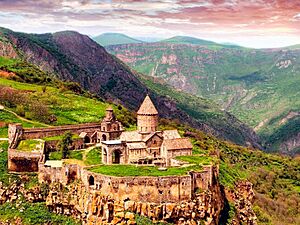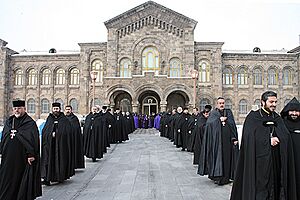Armenian Apostolic Church facts for kids
Quick facts for kids  Armenian Apostolic Church |
|
|---|---|
| Հայ Առաքելական Եկեղեցի (Armenian) | |
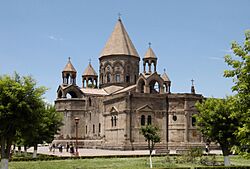
Etchmiadzin Cathedral, the mother church of the Armenian Apostolic Church
|
|
| Classification | Eastern Christian |
| Orientation | Oriental Orthodox |
| Scripture | Septuagint, New Testament, Armenian versions |
| Theology | Miaphysitism |
| Polity | Episcopal |
| Governance | Mother See of Holy Etchmiadzin |
| Head | Karekin II the Catholicos of All Armenians |
| Associations | World Council of Churches |
| Region | Armenia, Armenian diaspora |
| Language | Classical Armenian |
| Liturgy | Armenian Rite |
| Headquarters | Etchmiadzin Cathedral, Mother See of Holy Etchmiadzin, Vagharshapat, Armenia |
| Founder | Gregory the Illuminator Bartholomew the Apostle Thaddeus of Edessa |
| Origin | c. 1st century Kingdom of Armenia |
| Independence | 610 at the Third Council of Dvin |
| Separated from | Patriarchate of Constantinople in the Second Council of Dvin (554) |
| Separations | Armenian Catholic Church Hetanism |
| Members | 9,000,000 (self-reported) |
| Other name(s) | Armenian Church |
|
|
The Armenian Apostolic Church (Armenian: Հայ Առաքելական Եկեղեցի, romanized: Hay Aṙak'elakan Yekeghetsi) is the national church of Armenia. Part of Oriental Orthodoxy, it is one of the most ancient Christian institutions. The Kingdom of Armenia was the first state to adopt Christianity as its official religion under the rule of King Tiridates III, of the Arsacid dynasty in the early 4th century. According to tradition, the church originated in the missions of Apostles Bartholomew and Thaddeus of Edessa in the 1st century. St. Gregory the Illuminator was the first official primate of the church. It is sometimes referred to as the Armenian Apostolic Orthodox Church, Armenian Church or Armenian Gregorian Church.
The Armenian Apostolic Church should not be confused with the fully distinct Armenian Catholic Church which is an Eastern Catholic Church in communion with the Holy See in Rome.
Contents
History
Origins
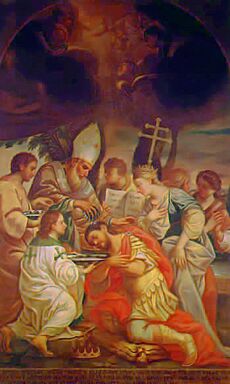
The Armenian Apostolic Church believes in apostolic succession through the apostles Bartholomew and Thaddeus (Jude). According to tradition, the latter of the two apostles is said to have cured Abgar V of Edessa of leprosy with the Image of Edessa, leading to his conversion in AD 30. Thaddaeus was then commissioned by Abgar to proselytize throughout Armenia, where he converted King Sanatruk's daughter, who was eventually martyred alongside Thaddeus when Sanatruk later fell into apostasy. After this, Bartholomew came to Armenia, bringing a portrait of the Virgin Mary, which he placed in a nunnery he founded over a former temple of Anahit. Bartholomew then converted the sister of Sanatruk, who once again martyred a female relative and the apostle who converted her. Both apostles ordained native bishops before their execution, and some other Armenians had been ordained outside of Armenia by James the Just. Scholars including Bart Ehrman, Han J.W. Drijvers, and Walter Bauer dismiss the conversion of Abgar V as fiction.
According to Eusebius and Tertullian, Armenian Christians were persecuted by kings Axidares, Khosrov I, and Tiridates III, the last of whom was converted to Christianity by Gregory the Illuminator. Ancient Armenia was the first state to adopt Christianity as a state religion, which has been referred to by Nina Garsoïan as "probably the most crucial step in its history." This conversion distinguished it from its Iranian and Mazdean roots and protected it from further Parthian influence. According to Mary Boyce, the acceptance of Christianity by the Arsacid-Armenian rulers was partly in defiance of the Sassanids.
When King Tiridates III made Christianity the state religion of Armenia between 300 and 301, it was not an entirely new religion there. It had penetrated the country from at least the third century, and may have been present even earlier.
Tiridates declared Gregory to be the first Catholicos of the Armenian Apostolic Church and sent him to Caesarea to be consecrated. Upon his return, Gregory tore down shrines to idols, built churches and monasteries, and ordained many priests and bishops. While meditating in the old capital city of Vagharshapat, Gregory had a vision of Christ descending to the earth and striking it with a hammer. From that spot arose a great Christian temple with a huge cross. He was convinced that God intended him to build the main Armenian church there. With the king's help he did so in accordance with his vision, renaming the city Etchmiadzin, which means "the place of the descent of the Only-Begotten".
Initially, the Armenian Apostolic Church participated in the larger Christian world and was subordinated to the Bishop of Caesarea. Its Catholicos was represented at the First Council of Nicea (325). St. Vrtanes I, the third Catholicos of the Armenian Apostolic Church (333–341), sent a letter with specific questions to Macarius, the Orthodox Bishop of Jerusalem (312-335/36), taken to Jerusalem by a delegation of Armenian priests on the occasion of the Encaenia, in dedication of the Church of the Holy Sepulchre in September 335. In Macarius's letter to the Armenians in 335, it seeks to correct irregularities in the initiation rites of baptism and the eucharist in use in the Armenian Church by articulating the practices in Jerusalem. In so doing, it reveals the divergent forms being practiced in Armenia, which have strong echoes of old East Syriac Rite. Orthopraxy was conceived by Vrtanes and his Armenian colleagues in terms of liturgical performance in Jerusalem. In 353, King Papas (Pap) appointed Catholicos Husik without first sending him to Caesarea for commissioning. The Armenian Catholicos was still represented at the First Council of Constantinople (381).
As Gregory was consecrated by the bishop of Caesarea, he also accepted the Byzantine Rite. However, the Armenian Church, due to the influence of the Church in Edessa, the large presence of Syriacs in Armenia, as well as the number of Syriac priests that arrived in Armenia with Gregory, also cultivated the West Syriac or Antiochian Rite. Since Armenians at the time did not have an alphabet, its clergy learned Greek and Syriac. From this synthesis, the new Armenian Rite came about, which had similarities both with the Byzantine and the Antiochian Syriac rite.
Christianity was strengthened in Armenia in the 5th century by the translation of the Bible into the Armenian language by the native theologian, monk, and scholar, Saint Mesrop Mashtots. Before the 5th century, Armenians had a spoken language, but no script. Thus, the Bible and liturgy were written in the Greek or Syriac scripts until Catholicos Sahak Part'ew commissioned Mesrop to create the Armenian alphabet, which he completed in c. 405. Subsequently, the Bible and liturgy were translated into Armenian and written in the new script. The translation of the Bible, along with works of history, literature and philosophy, caused a flowering of Armenian literature and a broader cultural renaissance.
Although unable to attend the Council of Ephesus (431), Catholicos Isaac Parthiev (Sahak Part'ew) sent a message agreeing with its decisions. However, non-doctrinal elements in the Council of Chalcedon (451) caused certain problems to arise.
Independence
Monophysitism spread from Syria to Armenia, from where it came to Georgia and Caucasian Albania.
At the First Council of Dvin in 506, the synod of the Armenian, Georgian, and Caucasian Albanian bishops was assembled during the time in office of Catholicos Babken I. The participation of the Catholicoi of Georgia and Albania was set to make clear the position of the churches concerning the Council of Chalcedon. The "Book of Epistles" mentions that 20 bishops, 14 laymen, and many nakharars (rulers of Armenia) participated in the council. (The involvement in the council discussion of different levels of lay persons seemed to be a general rule in Armenia.)
Almost a century later (609–610), the Third Council of Dvin was convened during the reign of Catholicos Abraham I of Aghbatank and Prince Smbat Bagratuni, with clergymen and laymen participating. The Georgian Church disagreed with the Armenian Church, having approved the christology of Chalcedon. This council was convened to clarify the relationship between the Armenian and Georgian churches. After the Council, Catholicos Abraham wrote an encyclical letter addressed to the people, blaming Catholicos Kurion of the Georgian Church and his adherents for the schism. The Council never set up canons; it only deprived Georgians from taking communion in the Armenian Church. Despite this, the Albanian Church remained under the jurisdiction of the Armenian Church while also in communion with the Georgian Church.
20th century
In 1903, the Tsarist government of the Russian Empire moved to confiscate the property of the Armenian Church.
Miaphysitism versus monophysitism
Like all Oriental Orthodox Churches, the Armenian Church has been referred to as monophysite by both Roman Catholic and Eastern Orthodox theologians because it rejected the decisions of the Council of Chalcedon, which condemned the belief of one incarnate nature of Christ (monophysis). The Armenian Church officially severed ties with Rome and Constantinople in 610, during the Third Council of Dvin where the Chalcedonian dyophysite christological formula was rejected.
However, again like other Oriental Orthodox Churches, the Armenian Apostolic Church argues that the identification as "monophysitism" is an incorrect description of its position. It considers Monophysitism, as taught by Eutyches and condemned at Chalcedon, a heresy and only disagrees with the formula defined by the Council of Chalcedon. The Armenian Church instead adheres to the doctrine defined by Cyril of Alexandria, considered as a saint by the Chalcedonian churches as well, who described Christ as being of one incarnate nature, where both divine and human nature are united (miaphysis). To distinguish this from Eutychian and other versions of Monophysitism this position is called miaphysitism. Whereas the prefix "mono-" (< Greek μονο- < μόνος) means "single, alone, only", thus emphasising the singular nature of Christ, "mia" (μία "one" FEM), simply means "one" unemphatically, and allows for a compound nature.
In recent times, both Chalcedonian and non-Chalcedonian churches have developed a deeper understanding for each other's positions, recognizing their substantial agreement while maintaining their respective positions.
Structure and leadership
According to The Armenian Church by Archdeacon Dowling published in 1910 (before the Great War and the Armenian Genocide), the Armenian Apostolic Church was composed of four patriarchal provinces, comprising at that date seventy-two, six, and two dioceses in Turkey, Russia, and Iran, respectively.
Two Catholicosates
The Armenian Apostolic Church currently has two sees. First, there is the Catholicos of All Armenians residing in Etchmiadzin, Armenia, at the Mother See of Holy Etchmiadzin. Second, there is the Catholicosate of the Great House of Cilicia, headquartered since 1930 in Antelias, Lebanon. The Catholicos of Etchmiadzin has pre-eminent supremacy in all spiritual matters over the See of Cilicia, which however administers to the dioceses under its jurisdiction as they see fit.
The Armenian Catholic Church is completely distinct from the Armenian Apostolic Church and is headed by its own Patriarch-Catholicos.
Two Patriarchates: Constantinople and Jerusalem
The Armenian Apostolic Church has two Patriarchates of high authority, both under the jurisdiction of the Catholicos of All Armenians:
- The Armenian Patriarchate of Jerusalem (Armenian: Առաքելական Աթոռ Սրբոց Յակովբեանց Յերուսաղեմ, literally Apostolic Seat of St. James in Jerusalem), whose seat is in the Armenian Quarter of Jerusalem. It is headed since 2013 by the Patriarch of Jerusalem, Archbishop Nourhan Manougian.
- The Armenian Patriarchate of Constantinople (Armenian: Պատրիարքութիւն Հայոց Կոստանդնուպոլսոյ) and All of Turkey, which has jurisdiction in the modern-day Republic of Turkey. Its seat is in Istanbul, Turkey and is headed since 2019 by the Armenian Patriarch of Constantinople, Archbishop Sahak II Mashalian.
Eparchies (dioceses)
List of eparchies:
Armenia
- Aragatsotn eparchy
- Diocese of Armavir
- Ararat Patriarchal eparchy
- Artik eparchy
- Gegharkunik eparchy
- Gougark eparchy
- Kotayk eparchy
- Shirak eparchy
- Syunik eparchy
- Tavush eparchy
- Vayots Dzor eparchy
- Artsakh eparchy
Dioceses/exarchates of the Diaspora
- Europe
- Diocese of Russia and New Nakhichevan
- Diocese of Southern Russia
- Diocese of Ukraine
- Exarchate of Central Europe
- Exarchate of Western Europe
- Diocese of Georgia
- Diocese of Romania
- Diocese of Bulgaria
- Diocese of Greece
- Diocese of Germany
- Diocese of Switzerland
- Diocese of France
- Diocese of Great Britain and Ireland
- Middle East
- Diocese of Egypt
- New World
- Diocese of Canada
- Western Diocese (USA)
- Eastern Diocese (USA)
- Diocese of Australia and New Zealand
- Diocese of Argentina
- Diocese of Uruguay
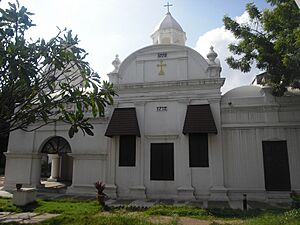
Seminaries
The Mother See of Holy Etchmiadzin operates two seminaries, the Gevorkian Theological Seminary at the Mother See of Holy Etchmiadzin, and the Vaskenian Theological Academy at Lake Sevan.
St. Nersess Armenian Seminary in Armonk, NY also trains Armenian priests, awarding the Master of Divinity in Theology (through an affiliation with nearby OCA St. Vladimir's Seminary). St. Nersess also offers a Master of Arts in Armenian Christian Studies.
Women in the Armenian Church
The Armenian Church does not ordain women to the priesthood. Historically, however, monastic women have been ordained as deacons within a convent environment. When ordained to the diaconate, "men and women are ordained to the diaconate using the same rite, with both having functions of chanting the Gospel and serving in the Divine Liturgy." Monastic women deacons generally do not minister in traditional parish churches or cathedrals, although the late Mother Hrip'seme did minister and serve during public liturgies, including in the United States. An order of nuns who are deaconesses continue to exist at the Sourp Hripsime Church in Etchmiadzin in Armenia. A woman was ordained in 2017 as a "parish deacon," in Tehran, Iran within the Catholicosate of Cilicia, for St. Sarkis Cathedral.
Women do serve as altar girls and lay readers, especially when a parish is so small that not enough boys or men are regularly available to serve. Women commonly serve the church in the choir and at the organ, on parish councils, as volunteers for church events, fundraisers, and Sunday schools, as supporters through Women's Guilds, and as staff members in church offices. In the case of a married priest (Der Hayr), the wife of the priest generally plays an active role in the parish and is addressed by the title Yeretzgin.
In limited circumstances, the Armenian Church allows for divorce and remarriage.
Armenian genocide victims canonization
On April 23, 2015, the Armenian Apostolic Church canonized all the victims of the Armenian genocide; this service is believed to be the largest canonization service in history. 1.5 million is the most frequently published number of victims, however, estimates vary from 700,000 to 1,800,000. It was the first canonization by the Armenian Apostolic Church in four hundred years.
Army Chaplaincy Program
The Army Chaplaincy Program of the Armenian Church is made up of more than 50 clergymen serving as military chaplains to the Armed Forces of Armenia. They organize various religious programs in the military, including delivering lectures and prayers. It is jointly funded and sponsored by the Ministry of Defence of Armenia and the Armenian Apostolic Church. All army chaplains are commissioned officers in the armed forces who hold a military rank. It was established in 1997 on the basis of a joint initiative of Catholicos Karekin I and Defense minister Vazgen Sargsyan. Since 2011, combined clergy company has taken part in the quinquennial Armenian Independence Day Parade on Republic Square in Yerevan.
Current state
In Armenia
The status of the Armenian Apostolic Church within Armenia is defined in the country's constitution. Article 8.1 of the Constitution of Armenia states: "The Republic of Armenia recognizes the exclusive historical mission of the Armenian Apostolic Holy Church as a national church, in the spiritual life, development of the national culture and preservation of the national identity of the people of Armenia." Among others, ethnographer Hranush Kharatyan has questioned the constitutionality of the phrase "national church".
In 2009, further constitutional amendments were drafted that would make it a crime for non-traditional religious groups to proselytize on adherents of the Apostolic Church. Minority groups would also be banned from spreading 'distrust' in other faiths. Hrant Bagratyan, former Prime Minister of Armenia, condemned the close association of the Armenian Apostolic Church with the Armenian government, calling the Church an "untouchable" organisation that is secretive of its income and expenditure.
In Artsakh
After the Bolshevik revolution and the subsequent Soviet occupation of Armenia, all functioning religious institutions in the NKAO were closed down and clergymen often either exiled or shot.
After a while the Armenian Apostolic Church resumed its activities. There were weddings, baptisms, and every Sunday Patarag at a free will attendance basis. The Armenian Apostolic Church since 1989 restored or constructed more than 30 churches worldwide. In 2009 the Republic of Artsakh government introduced a law entitled "Freedom of Conscience and Religious Organisations", article 8 of which provided that only the Armenian Apostolic Church is allowed to preach on the territory of the Republic of Artsakh. However, the law did make processes available for other religious institutions to get approval from the government if they wished to worship within the Republic.
Armenian diaspora

Outside of West Asia, today there are notable Armenian Apostolic congregations in various countries in Europe, North America, South America, and South Asia.
Lebanon, home to a large and influential Armenian diaspora community with its own political parties, has more than 17 recognized Armenian Apostolic churches.
The Armenian Patriarchate of Constantinople in Turkey and the Armenian Apostolic Church of Iran are important communities in the diaspora. These churches represent the largest Christian ethnic minorities in these predominantly Muslim countries.
The United Kingdom has three Armenian churches: St Sarkis in Kensington, London; Saint Yeghiche in South Kensington, London; and Holy Trinity in Manchester.
Ethiopia has had an Armenian church since the 1920s, when groups of Armenians were invited there after the Armenian genocide by Turkey.
See also
 In Spanish: Iglesia apostólica armenia para niños
In Spanish: Iglesia apostólica armenia para niños
- Religion in Armenia
- Armenian Catholic Church
- Armenian church architecture
- Armenian Patriarchate of Constantinople
- Armenian Patriarchate of Jerusalem
- Holy See of Cilicia
- Saint Narek chapel
Lists
- List of Catholicoi of Armenia
- List of Armenian Catholicoi of Cilicia
- List of Armenian Patriarchs of Constantinople
- List of Armenian Patriarchs of Jerusalem



